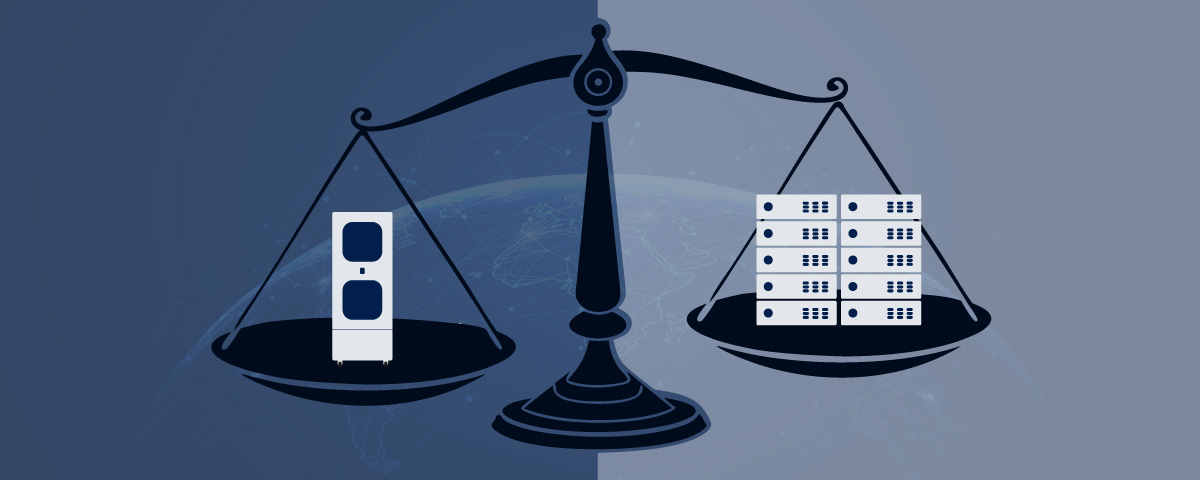Computers and humans like similar conditions, a MacBook Pro for example works best in a temperature range of 10 to 35°C (50 to 95°F). The iPhone X, has a slightly wider operating range of 0 to 35°C (32 to 95°F). Servers in data racks need a similar temperature range too, the trouble is they generate heat, a lot of heat, and keeping them comfortably cool takes a lot of energy, figuratively and literally.
How hot do servers get?
Well, data centre designers use a guide of 1BTU/hour/3 watts as rule of thumb. For a more readily understood sense of the amount of heat IT appliances can create you only have to go on YouTube for a few minutes to see hilarious cooking demonstrations on various computer CPUs: bacon and eggs seems to be a recurring theme.
Now put a stack of CPUs into a confined space, work them under loads for hours on end and then you’re really cooking. No wonder climate control typically accounts for 35-50% of energy consumption in a data centre, and not so surprising then that Big-IT likes to build the new breed of Hyper Data Centres in cool climates. Hello Norway, we’re looking at you. So, if you’re designing a data centre for use in Australia, you’re up against it – temperature wise – and we haven’t even started on dust yet.
How over-heating works up close
Okay, so let’s go back to conditions that humans enjoy: there’s nothing like snuggling up in bed under a feather down duvet or comforter. The reason we love them is they’re light and toasty warm. These attributes come from ‘down’ the lovely light fluffy material from a duck or goose’s breast and underside. Those light fluffy filaments of down help to trap air and each little pocket of air helps insulate and keep our body heat in. They also allow moisture to pass through, so we never get clammy – just toasty warm. But when your body is a piping-hot CPU that can cook an egg, keeping all that heat in isn’t so good. This is where humans and computers go their separate ways.
Dust creates an all-encompassing, wrap-around duvet for servers. Silently building-up over time, slowly choking its ventilation and cooling capability. Gravity gently places dust on all the upward facing surfaces and static helps it cling to the underside, and pretty soon dust smothers all those tiny little circuit board components, and the airflow vents and even the rotating fans trying to keep them cool. Remember just one degree over the manufacturers specified range and you’re likely to have no warranty on an appliance that can cost the same price as a new Toyota Corolla
When the dust hits the fan
It only takes a small amount of dust to create a big problem: a build-up of just two millimetres on those small fan blades can reduce airflow by 30%, and this is at the same time that the ventilation grills in the casework are being clogged-up too – further reducing airflow by another 30%. It doesn’t take long before things become critical and, oops… the spinning wheel of death appears on your screen, or worse still it all just goes black.
Australia’s resources sector is a global leader and also a huge user of progressive IT. In many remote parts of Australia the dust can be a talcum-powder-fine red dust that magically gets in anywhere: it’s simply impossible to keep out. Ask anyone whose done FIFO time up north, or even anyone who’s had to wash mine site clothes about the dust in their laundry. Now this fine red dust is especially cruel to computers as it has an abrasive quality, so if it doesn’t simply clog up your circuits, casework and fans it’ll destroy the little fan motors too.
Counting the cost
But wait, like any good horror movie… there’s worse to come. Summer in Australia means the monsoon arrives in the North, people start going-troppo because of the relentless heat and humidity and that’s when things get really bad. The condensation that looks so enticing on the outside of a tall, cold drink is deadly on the inside of your IT appliances. Those racks that you’ve been trying so hard to keep cool are chilled, ready to condense any water vapour in the hot, humid air. The ever-present dust in the appliance then acts as a wick, carrying the moisture right across every internal surface. What started as a little bit of dust is now a perilous film ready to cause a short circuit across a PCB or transfer a voltage spike and make the whole thing electronic-landfill in a blink.
So, what we did was…
After seeing too many fatally baked servers in these harsh conditions, remote IT specialist Clinton Keeler knew there had to be a better way. Even though the resource companies were prepared to accept the regular turnover of expensive appliances as a part of the high operational costs of the remote and harsh conditions. Angie Keeler who worked in the resources sector, could see that as reliance on remote IT was increasing, the risks associated with failure were increasing too, especially in the resources sector when it was monitoring or controlling safety functions or holding mission critical data. And so, their core concept of the robust micro data centre was born.
Relax this summer
Zella Pro is a fully sealed, self-contained data centre in a box ready to plug-and-play anywhere on earth, regardless of the conditions you throw at it. All the critical functions that you’ll find in a micro data centre are built-in to a Zella Pro: power conditioning with no-fail back-up options, sophisticated climate control and performance monitoring, physical and digital security with strictly controlled access, Zella Pros are modular and scale up as required. Unlike a regular data centre or server room, a Zella Pro can be relocated with only a few hours’ notice.
As you’d expect the Zella Pro is well insulated acoustically and thermally. Noisy data rooms run at around 75-95Db (one meter from a lawnmower is 90db). But a Zella Pro operates at around 35Db – the noise level of a suburban library, so it’s perfectly practical to place them in the centre of an open plan office. The insulation and small air volume also mean that it’s incredibly efficient to cool, office power savings of 70% have been reported back.
Get proactive. Get Zella DC.
Ten years of perpetual development mean that Zella Pros are a very sophisticated and capable solution, equally at home in a trending shared workspace, serving a remote resource project, or even at sea in a luxury superyacht – which is a nice place to be if you’re having a summer in Australia.
Get in touch if you’d like to find out more.






